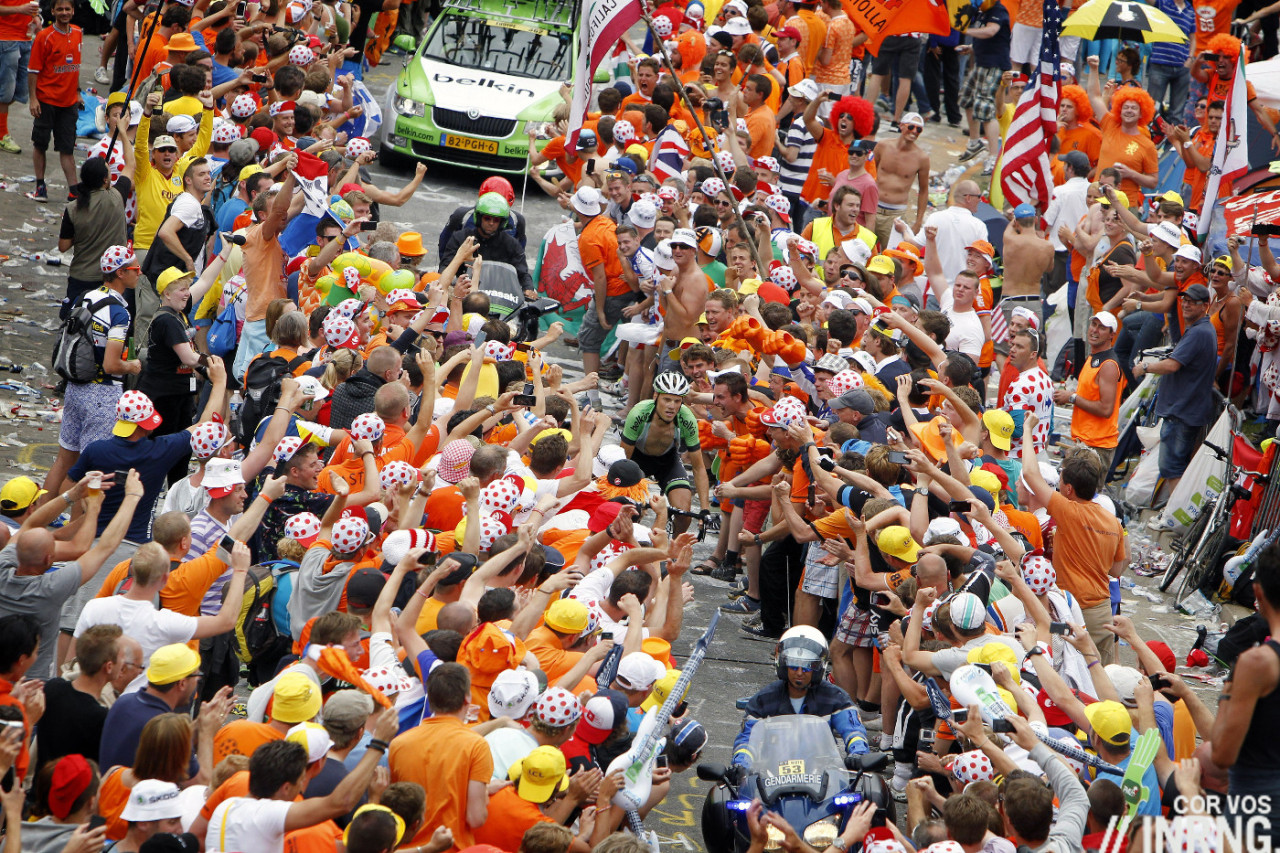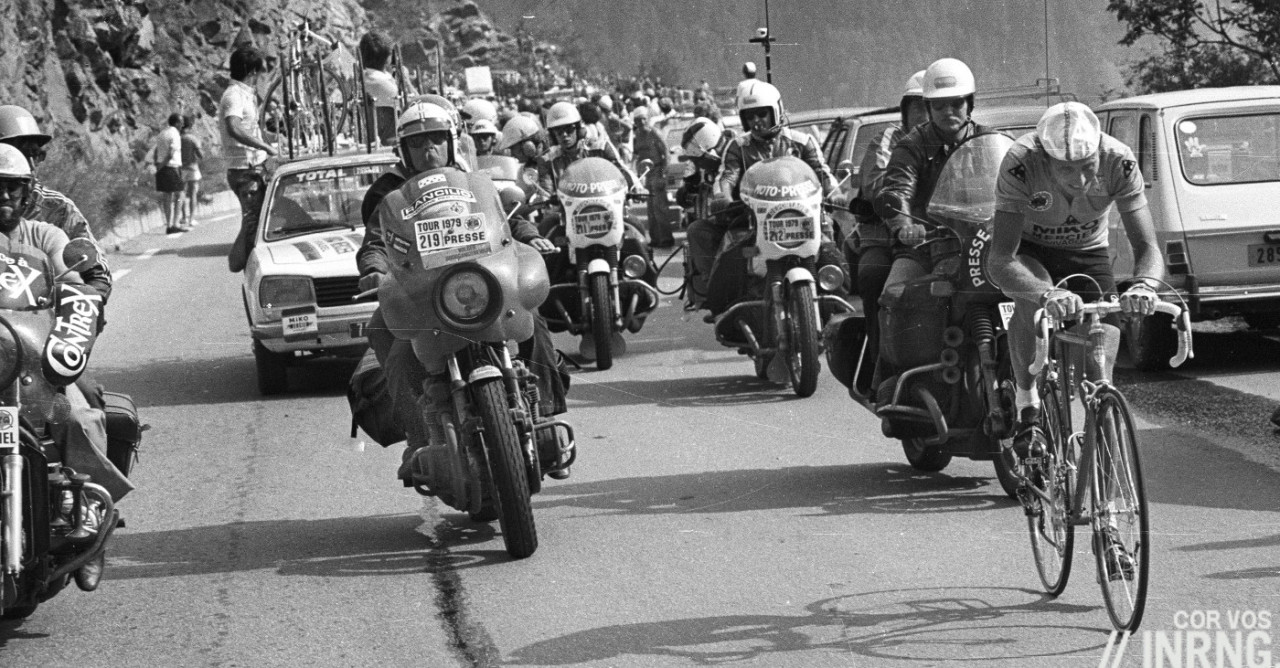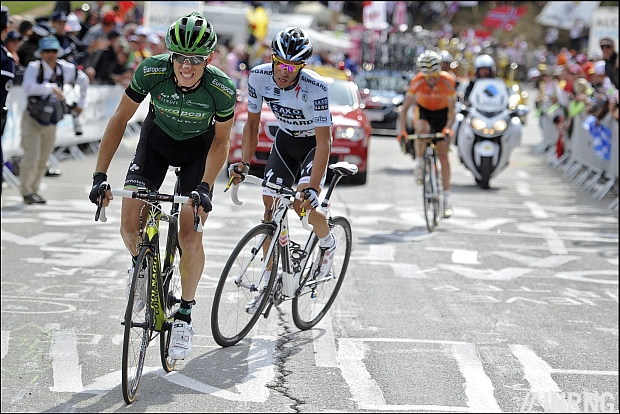Alpe d’Huez – Cycling’s Greatest Climb by Peter Cossins
Is Alpe d’Huez cycling’s most famous climb? There are many better roads to ride but the Alpe draws in the crowds like no other.
What makes Alpe d’Huez so popular? You might say the numbered hairpin bends, you could enjoy the views or maybe it’s all those famous stages of the Tour de France. But surely it’s the crowd that defines this climb, no other ascension sees such a communion between the riders and the fans? This book takes a closer look at the famous climb and how it gained it’s status and tells the story of those who suffered and shined on the way up.

The book’s introduction covers a lot of ground as Peter Cossins touches on the crowds that define this climb; he correctly identifies there are 22 hairpin bends rather than the 21 everyone usually quotes; and he explains the summit finish as a televisual concept designed to delay the suspense until late and to a scheduled time. It’s also made clear the Tour de France visits Alpe d’Huez so often simply because the ski resort is willing to pay up. Ten pages in and several big ideas have been identified and explained. What’s next?
Plenty with all sorts of details. There is the history of the climb, both the road itself and its appearances in the Tour de France. It’s a recent phenomenon with one visit in 1952 and then not again until 1976 where upon it’s been a regular feature on the route. This is a modern climb. It does not have the heritage of the Col du Tourmalet or Mont Ventoux but somehow draws more people in. Alpe d’Huez’s tourist office is only too welcome to pay for the race. Once upon a time the hoteliers were cautious to put up the money, today the fee is €300,000 but the office de tourisme gladly pays estimating the race brings in €10 million of benefits. There are lots of details, perhaps you’ve heard some stories before like the priest on the Alpe who was also the local agent for the Heineken brewery? The book rounds up all these stories.
Why those big crowds? Buy the book but the short cut is that the race became a magnet for Dutch fans thanks to a generation of Netherlanders racing for yellow and stage wins, helped by the maniacal radio commentary of Theo Koomen, at times impossible to stop and who resorted to inventing things to make the radio more interesting. Plus the Tour just kept visiting because it was found a resort willing to pay. Success breeds success. But this brings problems with drunken fans and worse.

Many chapters cover the various riders who made their name there. Joop Zoetemelk is given a sympathetic chapter which sets out to bust the “wheelsucker” myth of the rider whose pale skin was once cruelly explained by the fact that he spent so long in Eddy Merckx’s shadow. There’s the inevitable doping chapter but perhaps the dedicated chapter helps to contain this topic.
Each chapter is interspersed by the story of the 1976 Tour de France’s ascent of the mountain with an almost pedal stroke by pedal stroke account. It works, you get great detail but because the story is spread across the book you’re not left fatigued by it.
“I think it’s a pretty dull climb. Sure, there’s all the history of it, but in my mind it’s more of a cycling stadium than a beautiful road”
– Andy Hampsten
1992 stage winner Andy Hampsten gives a good interview which covers plenty of ground, at one point he explains the crowds are so big he almost lost his sense of balance because he couldn’t tell up from down. He leads bike tours today and admits the climb is, in isolation, just a ski station access road and that the Alps have plenty more to offer. This forces Cossins to confront the reality that for 364 days of the year this is an engineered road without too much beauty; even the pleasant views on the way up are of the other side of the valley.
“I went back there again in 2012 for a charity event but I only rode up as far as bend seventeen, which is the one with my name on it… …I didn’t ride any further because I didn’t want to fuck up the memories I have from 2008. It was such a beautiful day.”
– Carlos Sastre
Alpe d’Huez is a stadium and you can ride up when you probably couldn’t throw or kick a ball in the Yankee Stadium or Nou Camp but just because you can doesn’t make it the same because the crowds aren’t there.

There are chapters on early winter sports and the development of Alpe d’Huez as a ski resort. There’s a brief mention of geology and later on there’s even a section about the mining activity that lasted for centuries. It’s not cycling but gives the reader wider sense of place and puts the sporting challenge into relief against the physical challenge of a coal mine at 2,000m. Still if the book goes this far to explaining the medieval silver mining techniques it’s a shame the cycling is so restricted to the Tour de France’s visits. The women’s Tour de France has visited, ditto the Critérium du Dauphiné and Alpe d’Huez is also central to the cyclosportif/gran fondo scene as “The Marmotte” was one of the first of its kind in the 1980s but this potentially big story it only gets a brief treatment.

The Verdict
I feared the book would succumb to the hype around this climb and build it up even more but Peter Cossins is measured in his praise. It was an enjoyable and informative read, loaded with Tour anecdotes and extra-sporting stories. Alpe d’Huez is the “Hollywood” climb with a celebrity status but the more you read this the more you’ll want to visit and try the slopes for yourself. Just go ride the others in the region too.
A copy of this book was sent for review. It was lost in an airport when it was half-read so I bought a copy in order to carry on enjoying it.
More book reviews at inrng.com/books


My friends and I chose the Alpe as our first (and so far only) visit to the Alps purely for the reasons mentioned. It is the Lords or Wembley of cycling and there was little debate between us on alternatives.
Sure, there are many more beautiful climbs or difficult climbs but having watched the climb so often on TV (clearly part of ADZ’s investment strategy) there was only one climb for us.
I stopped for 20 minutes on the climb up at Dutch Corner, just to soak it up and try to imagine the huge crowds binging on beer and cycling and what the atmosphere may be like.
We all love the Alpe and probably wouldn’t hesitate to return to the beautiful area it is situated.
Alpe d’Huez is an iconic climb for me. Perhaps THE iconic climb. I know we can all name others. But those hairpins and those mad fans. Its just somehow different.
Alpe d’Huez is an awful climb. The resort is nice, the views are good, and it must be fantastic for the pro’s, but for you and I it’s basically a main road with trucks and vans driving up and down it all day. It’s hardly like playing in the Nou Camp, unless Messi sucks diesel fumes whilst he plays these days? I made sure I rode it in the morning, in the shade, whilst the traffic was low. In the daytime, the traffic, my god. Horrendous, don’t go anywhere near it. Alpe d’Huez < Glandon/Croix de Fer.
Well yes. If you want a nice ride up to Alpe d’Huez then go up the Sarenne way. Apart from the gravel I don’t think there are many more spectacular, quieter climbs in all of the Alps. But the famous road to Alpe d’Huez is hardly a busy road (unless you go on a change over day in the ski season) and the road is wide enough that you are never bothered by the traffic. It’s hardly horrendous.
Ok, maybe I’m being dramatic calling it horrendous, but it’s certainly the busiest col I’ve ever seen by some margin. Apart from the time I cam across a vintage German tractor rally driving up the Stelvio. No joke. Now that WAS horrendous, but funny too.
Massive over-reaction Ross.
I’ve ridden it many times and it’s fine, certainly shouldn’t put you off which you are trying to do with comments like ‘don’t go anywhere near it’.
Inring – couple of typos in the first two paragraphs : ‘the Alpe draws in the crowds like other’ and ‘What Alpe d’Huez so popular?’
It sounds you have picked the wrong season or day of the week Ross. I rode it up in in Sept 2013 on a midweek day and loved it, not busy at all. If you pick the right time, you are fine up the Alpe.
“Basically a main road’.
No, no it isn’t.
The thing’s now a victim of its own success. I can still remember taking folks up there when pretty much NOTHING was going on, having to explain to them that in summer (except on race day) it’s dead while in winter there’s the ski biz. The only bike shop was a “Jean’s Bike & Mower” type operation. Years later I was blabbing on about this as we drove there, only to find the modern marketing machine had transformed the place…the fancy new bike shop doing a brisk business selling everything you could think of with the Alpe logo on it while seemingly dozens of rival tour operations were running support vehicles up and down and eateries at the top were full. The crazy excitement of race day was missing, leaving only the sound of cash registers ringing up the sales. We’ve not been back since.
It may just be a “ski station access road” but as a fan of pro cycling it feels more special than that when you climb it.
Climb the Glandon/Croix de Fer, the Col de Sarenne or other climbs in the area and you will be treated to beautiful vistas and quiet roads, for the cyclist in you it will be mind blowing. But the Alpe is different. Here you climb not looking at the views or even enjoying the physical challenge, instead you read the names on the hairpins, imagine the crowds on Dutch corner, flick it into the big ring on the flat bit at the top and sprint to the deserted finish line with images of winner in your mind.
If you live in the area or visit often I can imaging this fades as it just becomes a climb to nowhere but if you are visiting for the first time it’s a must. Even if you only have time for one climb.
I was trying to work this out, after all a lot of other climbs have more tour history or more ascents, I think it’s because it’s always the finish of a stage. Yes they have finished on top of the Tourmalet and the Galibier but only once each, often they are just the way to somewhere less important.
If the Alpe is on a stage it is always the main event.
I’ve never really understood the hype of alp d’huez. It’s probably because the first tour i watched (properly) was 2013, the Ventoux really stood out for me then.
I appeeciate your honesty about losing the review copy and buying your own to finish it out of enjoyment. Will keep an eye out for this. Thanks, as always.
It’s interesting that all none of Merckx’ or Anquetil’s 5 wins a piece included the Alpe. It was omitted for 24 years! I guess I’d better get the book to find out why!
I’d like to see the Tour cover some new climbs – plenty of them that have never or rarely been used – rather than the same ones all the time.
As for d’Huez, I’m sick of the crowds that flock to cycling generally – only there to drink, be on TV and make idiots of themselves – but this is always the worst day.
I think the Tour would do well to avoid it for a decade to allow this particular craze to wear off.
As pointed out above, it doesn’t have a great history in cycling until the mid-70s, so it could go away for a while.
The 70s is nearly 50 years ago. Most fans will have not known the TdF without it.
But still no hardship to get rid of it for a few years. And worth it for the benefits.
No chance. Look how bad the reaction has been to losing the kapelmuur in the Ronde. This would be that x 1000.
But d’Huez isn’t in the Tour every year, so – without announcement – you just leave it out for a few years and the morons in mankinis lose interest: the real fans will come back.
I’ve only been up the Alpe once – back in 2013, the day before the Criterium du Daphane rolled through town. It was fairly busy, though I don’t recall trucks or being over-whelmed by the traffic on the way up.
I loved having lots of other cyclists to pass and pace myself on, as well as the crowds on the side of the road cheering on those giving it a go! Huez is possibly the only climb I’ve ever encountered where your essentially surrounded by like-minded cyclists, experiencing the climb for themselves (outside of an actual race day).
It’s a unique climb which may succumb to boozy tourists one day of the year, but so what? the enthusiastic fervor is what makes the climb so special.
Did a week in the Alps in 2011. I rode up the Alpe the day before the tour. Crazy experience as the road was already closed to traffic but packed with cyclists and fans. Dutch corner was roaring. The climb is a grunt but is far from charming or majestic. It was the experience that day which made the climb special. Our climb the next morning from Huez up the Croix de Fer in spectacular weather (only day that didn’t rain on us all week!) possessed the grandeur which Alpe du Huez lacks but without the mystique which the Alpe has gained over the years. It’s the beauty of the TdF – there is something to be found for every cycling taste.